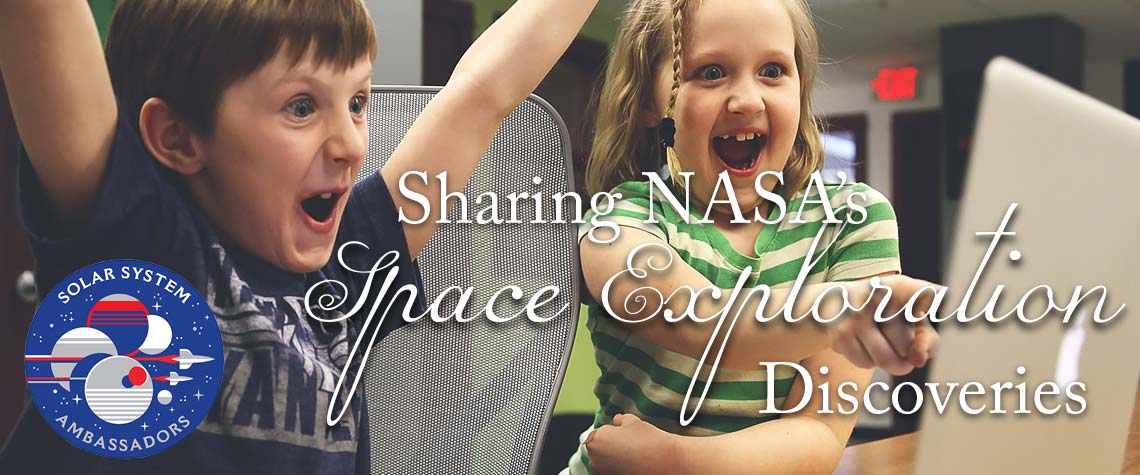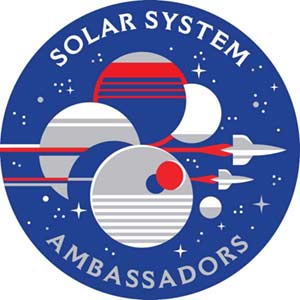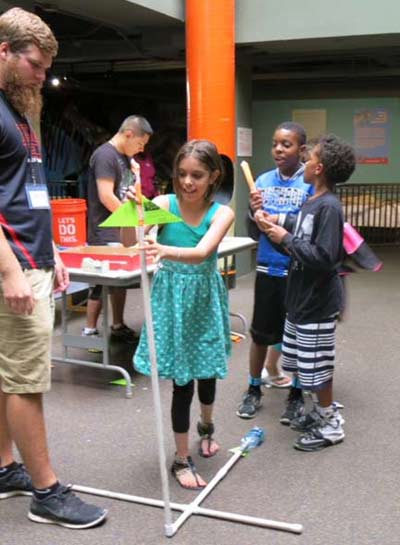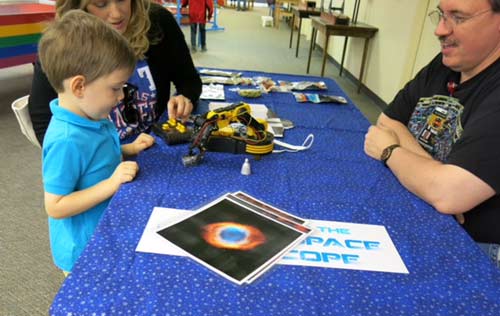Page 4


What is a Solar System Ambassador?
By Tom Campbell, NASA/JPL SSA
Like many great things in life, the Solar System Ambassador program had humble beginnings. In 1996, a teacher from New Hampshire attended a Galileo mission educator workshop. From his suggestion, the Galileo Ambassador Program was born in 1997 with 16 volunteers.
Program Formation
With support from other Jet Propulsion Laboratory (JPL) missions, the Galileo Ambassador Program expanded and changed its name. The Solar System Ambassadors program was formed in 1999 with 145 volunteers. The mission of the Solar System Ambassadors program (SSA) is to work with expert volunteers across the nation to share the latest science and discoveries of NASA's space exploration missions through a variety of inspirational events.
As of 2018, there are over 900 volunteers in 50 states, the District of Columbia, Puerto Rico, Guam, US Virgin Islands, and US citizens living abroad. Since the program started over 20 years ago, SSAs have run more than 40,000 events serving over 9,000,000 people directly.
Solar System Ambassadors get support from both NASA and JPL to help them with their outreach events. This includes training via teleconferences with engineers and personnel who work directly on the various missions, access to NASA materials and handouts, and access to a pool of NASA and JPL personnel as guest speakers.

The official Solar System Ambassador logo
Volunteers
Solar System Ambassadors are strictly volunteers and are not allowed to use the NASA or JPL logos on any self-promotional materials. Instead, an official logo has been created for them by NASA. Also, they are never allowed to accept money or other forms of compensation for the work they do in promoting the space program. They are well-informed individuals who have a passion for space and astronomy and love to share that passion with the world.
To keep their status active, SSAs must be part of at least four outreach events per year and send reports of their experiences to NASA. Summaries of these reports are given to the Science Missions Directorate each month to let them know how much the Ambassadors are doing to promote the various space missions.

An excited attendee prepares to launch her paper rocket.
Bringing Astronomy to the Public
I first became aware of the program in 2004. While browsing the NASA website, I came across the page about Solar System Ambassadors. On the site was a list of current ambassadors, so just for fun I scanned the list looking to see if any were nearby. As luck would have it, there was one in my own town!
I lived in a small town in rural Kansas, so this was quite surprising to me. I sent her an email stating that I was interested in organizing some sort of public star party for the upcoming Space Day and wondered if she'd be willing to help me out.
She replied right away saying she was excited about the opportunity to bring astronomy to the public. I invited an observing buddy to help us out and before long, my simple star party idea had turned into an all-day affair with guest speakers, a room full of exhibits, and plenty of hands-on activities such as a walk-through scale model of the solar system, an air rocket workshop, and even some actual moon rocks.
The event was a success, with about 150 people in attendance and a dozen or so people coming back in the evening for the star party. We vowed to do it again the next year, but the three of us got busy with other life events and we decided to skip a year.
After that, it seemed that things never worked out for us to have another Space Day fair. However, my observing friend and I would still host public star parties on occasion in the local Wal-Mart parking lot.
But I never really forgot about that Space Day Fair. Seeing all those kids (and even their parents) get excited about space exploration was wonderful and I wanted to see it again and again. In the back of my mind, I kept wanting to do another large event like that, but the local Solar System Ambassador was getting heavily involved in school projects and didn't have time to help me with organizing anything. And without her help, I lost all my connection to NASA handouts and other materials that made the event special.
Becoming a Solar System Ambassador
In 2011, I finally decided that if I was ever going to host another Space Day event again, I would need to get my own access to NASA materials. I would have to become an SSA myself. The SSA program only accepts applications during the month of September, so I bided my time and then applied as soon as submissions were allowed.
Imagine my disappointment when I received an email stating that I was not chosen. I looked through my application again (yes, I had saved a copy on my computer) and decided that the only area where I thought I had some control over improvement was in the area of outreach. I started doing some sidewalk astronomy and setting up my telescope in public places during planetary oppositions.
In September of 2013, I applied again. This time I was accepted, just a couple of weeks before I had to move to Lubbock, Texas for a new job. As soon as I got settled into my new role as software developer at Texas Tech, I contacted the physics department to see if there were any local astronomy clubs. One of the astronomy instructors gave me contact info for the local club and I started attending the meetings regularly.
Interestingly enough, the club president was also an SSA. We collaborated on a couple of projects, including a FIRST Robotics competition where the emphasis was on planetary rovers. I gave a talk comparing and contrasting the current rovers on Mars and ended with a demonstration of a radio controlled Martian rover I had built.
While still living in Lubbock, I helped organize another Space Day event at a children's science museum. Besides the aforementioned Martian rover, we also let the children build and fly paper rockets and manipulate a robotic arm to capture satellites and bring them aboard a shuttle bay. We had also intended on the astronomy club doing some solar viewing, but lack of sunspots and cloudy weather cancelled those plans.
As an introvert, the most difficult aspects of being an SSA for me are making new contacts and talking in front of a crowd of people. I've given a few talks at astronomy club meetings (including one for the BVAC), but that's a bit different. The crowd is usually small and consists mostly of people I already know. And in one-on-one situations, such as at a star party, my passion overcomes any fear, and I can talk as long as people are willing to listen.

A parent shows her child how to control a robotic arm.
That's also one of the great things about being an SSA. There's not one way to do things. Everybody has strengths and weaknesses, and being volunteers, we're allowed to use whatever methods we are most comfortable with. Some of us teach to children in a classroom setting. Others stand up and lecture in front of a room full of adults. Still others set up a booth at a county fair and hand out stickers and fact sheets. And some are like me and prefer to do my outreach while using my telescope as a security blanket.
If you'd like to become a Solar System Ambassador yourself, I'll be happy to point you in the right direction. If you know of a group or organization who'd love to have an SSA give a talk or set up an information booth for their event, please have them contact me.
Author: Tom Campbell
Email: avid.astronomer@yahoo.com
Website: astro.tomandjul.com
